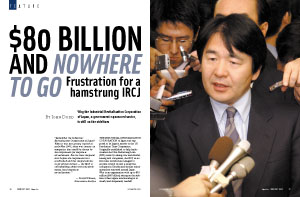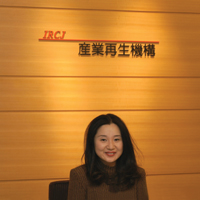$80 Billion and Nowhere to Go
Back to Contents of Issue: February 2004
|
|
|
|
by John Dodd |
|
|
THE INDUSTRIAL REVITALIZATION CORPORATION of Japan was supposed to be Japan's answer to the US Resolution Trust Corporation. Originally established to help banks weather the Non-Performing Loan (NPL) crisis by taking over and rehabilitating sick companies, the IRCJ in its first nine months has managed to acquire control of only a small bus company in Kyushu and similar minor operations scattered around Japan. Why is an organization with up to JPY10 trillion ($80 billion) sitting on the sidelines when urgent restructuring is so clearly and desperately needed?
Takenaka shock
The resulting defeat for Takenaka and his boss, Prime Minister Junichiro Koizumi, was embarrassing to say the least, but the result of the "Takenaka Shock," as the incident became known, was to awake others in the bureaucracy. Shortly thereafter, the Ministry of Finance and others, who were nonetheless extremely concerned about a possible banking system meltdown in 2003, floated a plan to establish a government-owned "back stop" organization (a type of government buy- out fund) that could acquire banks' troubled assets before those banks lost control.
The IRCJ was officially established on April 16, 2003, as a fully-owned subsidiary of the Deposit Insurance Corporation of Japan (DICJ). Whereas the Resolution and Collection Corporation (RCC) was in the business of retrieving and disposing of the assets of bust companies, the IRCJ was explicitly designed to step in before things got too bad.
From the outset, the IRCJ was intended to be a funnel for deals from the banks. For this reason there was no provision for "deal sourcing," normally an essential activity for private equity and buyout players such as Ripplewood and others. The IRCJ was never meant to be a replacement or proxy for the government to compete with private sector funds.
In 2002, the vision of an empowered and well-financed agency standing by to help as banks faltered in 2003 must have been a compelling one. The bureaucrats and government worked fast to get the IRCJ into place, and by the time of its launch, key supporters and senior staff were already in place. Ex-Nomura man Atsushi Saito was tapped to become the president, supported by a plethora of experienced men and women from leading Japanese and foreign consulting firms and banks. Indeed, even a number of senior managers from Ripplewood answered the call of their country (though they didn't go for the salary) and are now MDs in the organization.
Experts point a finger at a single common cause for the lack of deals: the banks. Since the organization was originally created to look after ailing companies through the banks, it is dependent on them for deal flow.
By late 2003, the 45 percent increase in the Japanese stock market was the largest improvement of any bourse in the world. The heat was suddenly off the banks to take action on their NPLs. Indeed, many banks started thinking that with such big gains, the very same "zombie" companies that contributed to their debt mountains might actually become worth something again. At the very least, it allowed them to stall for time while they put together their own restructuring funds and went to work on their own clients.
The attitude of the banks and the government's coddling of them is summed up by Lehman Brothers Chief Asian Economist, Paul Sheard: "The problem with the banking system in Japan does not actually come about through a lack of mechanisms to dispose of non-performing loans," Sheard tells us. "There are plenty of mechanisms to do that. The problem with the Japanese banks is the losses on the books the disposals would create, and the fact that there is no incentive to perform mark to market valuations there."
"If the government really wanted to use the IRCJ to expedite the recovery of the banking industry, it would be given a budget and it would aggressively buy up the non-performing loans. You would let the IRCJ do its buying at above market rates. Because that is not how the IRCJ is being run, it has been doomed from day one to have little impact on the macro banking scene. There is no sense of urgency."
The IRCJ appears to be afflicted with an internal problem as well -- that of "public servant principles." The organization has proved that it is not a tool of the politicians -- indeed, it is a creature of bureaucratic design. Thus it is not allowed to invest public money in a restructuring project unless it is sure that it can get that money back again.
Unfortunately, this is making the IRCJ exceedingly cautious and unwilling to offer above-market prices for the companies that the banks might want to sell. The banks, and particularly their sub-bank loan partners, are unwilling to bite the bullet and take the losses, and the IRCJ resists offering sweeteners to provide extra incentive.
Stuck with small fry
Of these, only the Mitsui company with its JPY70 billion of debts looked like serious game for the intensive turnaround activities of the IRCJ. But even this effort was spoiled when it emerged that Mitsui Mining had a worse financial situation than the one originally disclosed. The IRCJ almost had to tear up its plans for Mitsui Mining and send them back to the bank -- before finally deciding to do the deal after all, in December.
Takashi Kiuchi, an analyst at Kiuchi Economist Salon, defines the current thinking about the IRCJ. "I am a little cynical about the IRCJ," he concedes. "When it was first created, its purpose was to bypass the deadlocked private sector negotiations on non-performing loans. The government was hoping that the private sector would find its own solution.
As if the slow deal flow wasn't bad enough, the IRCJ is also starting to see competition from other politically charged government organizations. The IRCJ leadership will need to learn quickly how the game works. Already, METI, eternally locked in competition with the Ministry of Finance, has launched 10 regional restructuring funds to work with sick companies and their banks. The good news for the IRCJ is that these METI funds are not well endowed with cash, having just JPY20 billion between them, and are reportedly already talking to the IRCJ about doing some deals together.
Then there are the banks themselves. Mizuho, UFJ and others have realized that there is money to be made in restructuring and are establishing turnaround operations of their own. With the tools at their disposal, why would they be willing to sell assets at 20 cents on the dollar to the IRCJ?
Possible future
Typically, as a matter of maintaining public trust as servants of the government, these public sector creditors are generally not allowed to forgive debts and loans. Thus banks sharing loans with these organizations find themselves stuck, even if they were willing themselves to take a hit on the asset write-offs. For this reason, the IRCJ has a future working on companies with public debt as part of their make-up -- and there are plenty of them.
Also, the IRCJ is staffed by restructuring and operations experts. This makes the IRCJ unique among all the government agencies charged with tackling the NPL problem. IRCJ staffers can undertake a government turnaround operation that the RCC could not. As mentioned earlier, among the managing directors in the IRCJ's senior management ranks are some of the best restructuring brains in Japan. At least several of these individuals have established track records of engineering turn- arounds worth billions of dollars in the private sector.
The Japanese press has made much of the fact that the IRCJ has only 130 staffers and could only handle 20 or so patients at any one time. While this would be true if the work was kept inside the IRCJ, the organization is working closely with a number of private restructuring funds to leverage deals and manpower.
One such deal was announced in December of last year, when the Matsuya Denki chain of stores was put in the hands of Shinsei for rehabilitation. This is a unique melding of public finance and political pressure with private enterprise and expertise. In fact, the IRCJ has said a number of times that it would prefer to become a conduit and "shaper" of deals rather than the actual executor providing the restructuring teams.
However, as Heizo Takenaka said in a recent presentation in China and Hong Kong, "This is just the begining!" With input and assistance from the Financial Services Agency (FSA) pressuring the banks to accelerate disposal of their NPLs, the IRCJ and its JPY10 trillion of loan guarantees remains an extremely useful tool to have at Takenaka's disposal. Certainly all the media comments from Takenaka and Finance Minister Tanigaki seem to indicate that both ministers are cooperating and pushing the banks to make better use of the IRCJ.
The challenge for President Saito is to find a way to make the banks move faster and yield up bigger problem children. Initial opportunities may come from Resona, which the government chose not to take over entirely, but rather to control as a shareholder -- unlike Ashikaga Bank, which was forced into liquidation and taken over.
Resona retains operational control, but it is on a very, very short leash to the FSA and the DICJ -- both organizations with which the IRCJ has deep relationships.
Will the IRCJ be dissolved because of lack of activity? No one in government is saying this, a sure sign that they believe, like many in the financial markets, that the current improvement in Japan's financial numbers is less to do with government reform or resolution of NPLs, and more to do with buoyant orders from China for machinery.
Consider this: If the US economy falters in 2004, the NPL problem will look just as dangerous as it did in 2002. When the more vulnerable sectors of the economy begin to collapse, the IRCJ will provide the government with a means to push the banks to meet its original target of reducing the NPLs by 50% by 2005. @
|
|
Note: The function "email this page" is currently not supported for this page.


 "Remember the Industrial Revitalization Corporation of Japan? When it was just getting started in early May 2003, there was interest in companies that could be chosen by the corporation for corporate revitalization. But we were skeptical even before the corporation was established and this skepticism has so far proven correct -- the IRCJ is still muddling about with relatively minor, local corporate revitalizations."
"Remember the Industrial Revitalization Corporation of Japan? When it was just getting started in early May 2003, there was interest in companies that could be chosen by the corporation for corporate revitalization. But we were skeptical even before the corporation was established and this skepticism has so far proven correct -- the IRCJ is still muddling about with relatively minor, local corporate revitalizations."
 Unwilling banks and public principles
Unwilling banks and public principles
 "Also, at that time people thought a financial crisis centered on the banking sector was imminent. When the economy started to pick up a little, there was a sense of relief and the fear dissipated. The bankers have never been clear on the prices at which the IRCJ would acquire their assets. Because it was always uncertain, the IRCJ wound up only getting a few smaller companies."
"Also, at that time people thought a financial crisis centered on the banking sector was imminent. When the economy started to pick up a little, there was a sense of relief and the fear dissipated. The bankers have never been clear on the prices at which the IRCJ would acquire their assets. Because it was always uncertain, the IRCJ wound up only getting a few smaller companies."
 Time running out?
Time running out?



